List of Turkic dynasties and countries
The following is a list of dynasties, states or empires which are Turkic-speaking, of Turkic origins, or both. There are currently six recognized Turkic sovereign states. Additionally, there are six federal subjects of Russia in which a Turkic language is a majority, and five where Turkic languages are the minority, and also Crimea, a disputed territory between Ukraine and Russia where Turkic languages are the minority. There have been numerous Turkic confederations, dynasties, and empires throughout history across Eurasia.
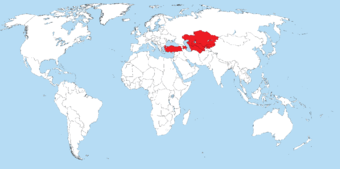
Contemporary entities with at least one Turkic language recognized as official
Current independent states
| Name | Years | Republic Day | |
|---|---|---|---|
| 1923 | 75% Turkish | October 29, 1923 | |
| 1991 | 2009 - 91.6% Azerbaijanis, 0.43% Turkish, 0.29% Tatars.[1] | May 28, 1918 | |
| 1991 | 63.1% Kazakhs, 2.9% Uzbeks, 1.4% Uyghurs, 1.3% Tatars, 0.6% Turkish, 0.5% Azerbaijanis, 0.1% Kyrgyz.[2] | June 19, 1925 | |
| 1991 | 70.9% Kyrgyz, 14.3% Uzbeks, 0.9% Uyghurs, 0.7% Turkish, 0.6% Kazakhs, 0.6% Tatars, 0.3% Azerbaijanis.[3] | October 14, 1924 | |
| 1991 | 75.6% Turkmens, 9.2% Uzbeks, 2.0% Kazakhs, 1.1% Turkish 0.7% Tatars[4] | October 27, 1991 | |
| 1991 | 71.4% Uzbeks, 4.1% Kazakhs, 2.4% Tatars, 2.1% Karakalpaks, 1% Crimean Tatars, 0.8% Kyrgyz, 0.6% Turkmens, 0.5% Turkish, 0.2% Azerbaijanis, 0.2% Uyghurs, 0.2% Bashkirs.[5] | October 27, 1924 |
Partially recognized state
Recognized only by Turkey.
| Name | Years | |
|---|---|---|
| 1983 | 67.54% Turkish Cypriots, 32.45% Turkish |
Federal subjects (Republics) of Russia
| Name | |
|---|---|
| 2010 – 29.5% Bashkirs, 25.4% Tatars, 2.7% Chuvash | |
| 2010 – 67.7% Chuvash, 2.8% Tatars | |
| 2010 – 41.0% Karachays, 3.3% Nogais | |
| 2010 – 53.2% Tatars, 3.1% Chuvash | |
| 2010 – 82% Tuvans, 0.4% Khakas | |
| 2010 – 49.9% Yakuts, 0.2% Dolgans, 0.9% Tatars |
| Name | |
|---|---|
| 2010 – 34.5% Altaians, 6.2% Kazakhs | |
| 2010 – 12.7% Balkars | |
| 2014 – 12.6% Crimean Tatars, 2.3% Tatars | |
| 2010 – 12.1% Khakas |
Autonomous regions
| Name | |
|---|---|
| 2004 – 82.1% Gagauz.[7] | |
| 36% Uzbeks, 32% Karakalpaks, 25% Kazakhs[8] | |
| 99% Azerbaijanis[9] | |
| China | |
| 2000 – 45.21% Uyghurs, 6.74% Kazakhs, 0.86% Kyrgyz, 0.066% Uzbeks, 0.024% Chinese Tatars, 0.02% Salars | |
| ↪ |
2010 – 64.68% Uyghurs, 27.32% Kyrgyz |
| ↪ |
2015 – 26.77% Kazakhs, 17.45% Uyghur |
| ↪ |
2000 – 34.01% Kazakhs, 0.16% Uyghur, 0.03% Chinese Tatars |
| ↪ |
Kazakhs |
| 2000 – 61.14% Salars | |
| Salars | |
| Yugur | |
| Kazakhs | |
Historical Turkic confederations, dynasties, and states
Tribal confederations
Royal clans
- Ashina (First Turkic Khaganate, Western Turkic Khaganate, Eastern Turkic Khaganate, Khazars, Nushibi, Second Turkic Khaganate)
- Ashide (Empress clan of Second Turkic Khaganate)
- Yaglakar (Uyghur Khaganate, Ganzhou Uyghur Kingdom)
- Ädiz (Uyghur Khaganate)
- Dulo clan (Volga Bulgaria)
- Bulanid (Khazars)
- Osman (Ottoman Empire)
- Bahri (Mamluk Sultanate)
- Sarkar (Shirvan Khanate)
- Javanshir (Karabakh Khanate)
- Terterids (Second Bulgarian Empire)
- House of Seljuq (Seljuk Empire, Sultanate of Rum, Kerman Seljuk Sultanate)
Turkic dynasties and states
| Name | Notes | Years | Capital | map |
|---|---|---|---|---|
| Founded by Bumin Qaghan after breaking away from Rouran Khaganate. | 552–ca. 580 | Otuken |  | |
| Western Turkic Khaganate | 593–659 | Navekat and Suyab | 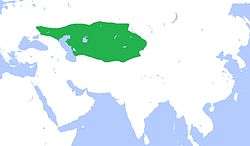 | |
| Eastern Turkic Khaganate | 581–630 639-650 |
Ordu Baliq | 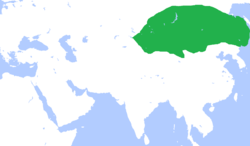 | |
| Xueyantuo | 628–646 | |||
| Kangar union | 659–750 | Located in Ulytau | ||
| 665–850 | Kabul | 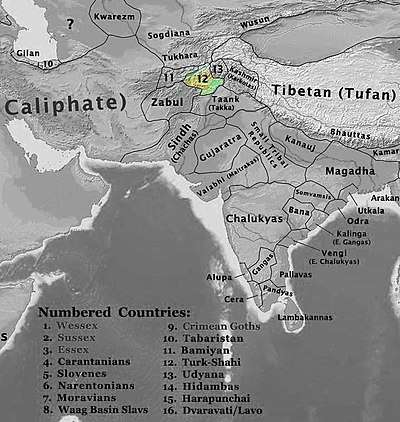 | ||
| Second Turkic Khaganate | Founded by Ilterish Qaghan. It was preceded by the First Turkic Khaganate (552-630) and then a period of Tang rule (630-682). | 682–744 | Otuken | |
| Türgesh | Türgesh were a Turkic tribal confederation of Dulu Turks believed to have descended from the Turuhe tribe situated along the banks of the Tuul River. They emerged as an independent power after the demise of the Western Turkic Khaganate and established a khaganate in 699. The Turgesh Khaganate lasted until 766 when the Karluks defeated them. | 699–766 | Balasagun | |
| Kimek–Kipchak confederation | 743–1220 | Khagan-Kimek Imekia | 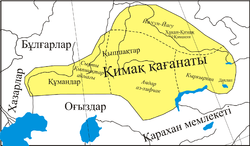 | |
| 744–848 | Ordu Baliq | 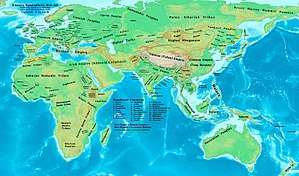 | ||
| Oghuz Yabgu State | 750–1055 | Yangikent | 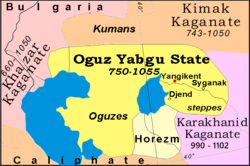 | |
| Karluk Yabgu State | 756–940 | Suyab later Balasagun |  | |
| 840–1212 | Balasagun, Kashgar, Samarkand | 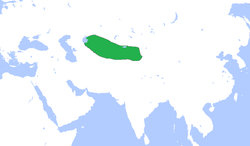 | ||
| Yenisei Kyrgyz Khaganate | 840–1207 | |||
| Kingdom of Qocho | 856–1335 | Gaochang, Beshbalik |  | |
| 860–1091 |  | |||
| Ganzhou Uyghur Kingdom | 894–1036 | Zhangye | 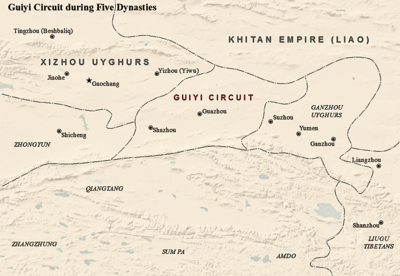 | |
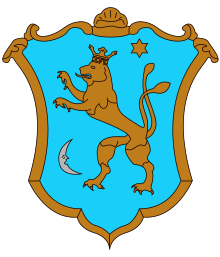 |
900–1220 | _en.png) | ||
| 11th–16th century | Many such as Karaman, Sinop, Adana, Alanya, Kahramanmaraş. | |||
| Ahmadilis | 1122–1209 | Maragha | 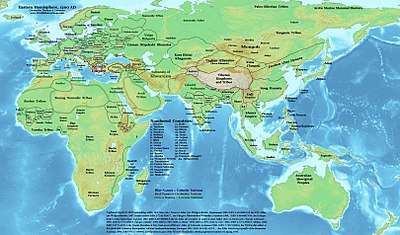 | |
| Eldiguzids | ca.1135–1225 | Nakhchivan (city) and Hamadan | ||
| Salghurids | 1148–1282 | Fars Province | ||
| Also known as the Turkish Empire, Ottoman Turkey or Turkey, was an empire founded in 1299 by Oghuz Turks under Osman I in northwestern Anatolia | 1299–1923 | Söğüt 1299–1335, Bursa 1335–1413, Edirne 1413–1453, Istanbul 1453–1922 | 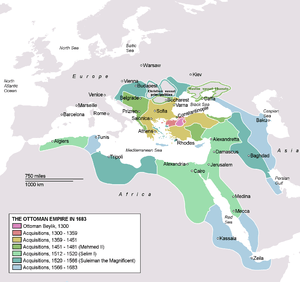 | |
| Kara Koyunlu | Kara Koyunlu was an Turkmen tribal federation.[12] | 1375–1468 | Tabriz |  |
| Emirate of Kasgharia | A short lived emirate in Kashgar region.[13] | 1865–1877 | Kashgar |
Europe
| Name | Notes | Years | Capital | Map |
|---|---|---|---|---|
| Khazar Empire | The Khazars were a semi-nomadic Turkic people, who created what for its duration was the most powerful polity to emerge from the break-up of the Western Turkic Kaganate.[14] | 6th–11th century | Balanjar 650–720 ca., Samandar (city) 720s–750, Atil 750-ca.965–969 | 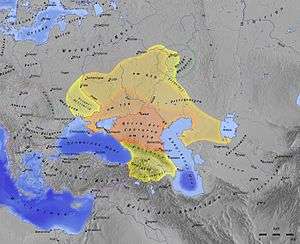 |
| 632–668 | Phanagoria 632–665 | 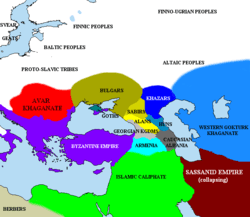 | ||
| Tengrist Turkic pre-Christianization;[15] became Slavic post-Christianization | 681–1018 | Pliska 681–893, Preslav 893–972, Skopje 972–992, Ohrid 992–1018 |  | |
| Volga Bulgaria | 7th century–1240s | Bolghar, Bilär | ||
| Terter dynasty | 1280–1323 | 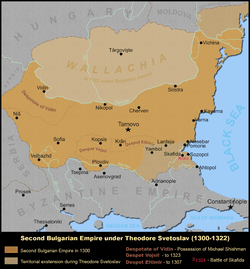 |
Middle East and North Africa
| Name | Notes | Years | Capital | Map |
|---|---|---|---|---|
| Tulunids | The Tulunids were a dynasty of Turkic origin[16] and were the first independent dynasty to rule Islamic Egypt, as well as much of Syria. | 868–905 | al-Qatta'i | |
| Ikhshidid Dynasty | Founded by a Turkic[17][18][19] slave soldier, was appointed governor by the Abbasid Caliph.[20] | 935–969 | ||
| Burid Dynasty | 1104–1154 | Damascus | 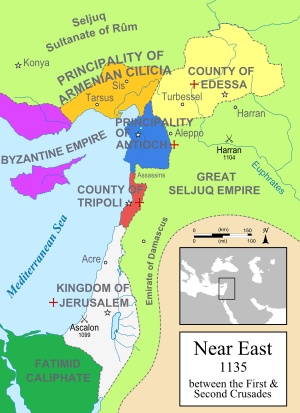 | |
| Zengid Dynasty | Dynasty of Oghuz Turk origin.[21] | 1127–1250 | Aleppo | |
| The first half of the Mamluk Sultanate was dominated by the Kipchak Turkic Bahri dynasty, after the Mongol conquest of the Kipchak steppes. | 1250–1389 | Cairo |  | |
| Assaf dynasty | Controlled region between Beirut and Byblos | 1306–1591 | Ghazir |
Maghreb region
| Name | Notes | Years | Capital | Map |
|---|---|---|---|---|
| Karamanli dynasty | The Karamanli dynasty was an independent or quasi-independent,[22] who ruled from 1711 to 1835 in Tripolitania (Tripoli and its surroundings in present-day Libya). At their peak, the Karamanlis' influence reached Cyrenaica and Fezzan, covering most of Libya. The founder of the dynasty was Pasha Ahmed Karamanli, a descendant of the Karamanids. | 1711–1835 | Tripoli |  |
Indian subcontinent
| Name | Notes | Years | Capital | Map |
|---|---|---|---|---|
| Mamluk Dynasty (Delhi) | Mamluk Dynasty was directed into Northern India by Qutb ud-Din Aibak, a Turkic Mamluk slave general from Central Asia. The Mamluk Dynasty ruled from 1206 to 1290.[23][24][25] | 1206–1290 | Delhi | |
| Qarlughid Dynasty | 1224–1266 | Ghazna, Binban | ||
| Khalji Dynasty | 1290–1320 | Delhi | 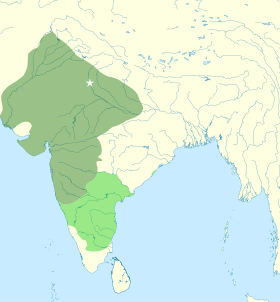 | |
| Tughlaq Dynasty | 1320–1414 | Delhi | ||
| Ilyas Shahi dynasty | 1342–1487 | Sonargaon | 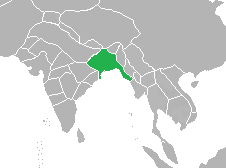 | |
| Bahmani Sultanate | 1347–1527 | Gulbarga (1347–1425) Bidar (1425–1527) |
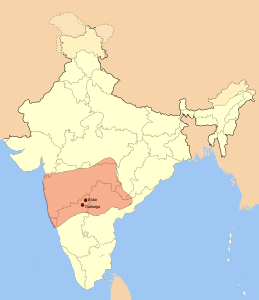 | |
| 1342–1538 1555–1576 |
Gaur Pandua Sonargaon |
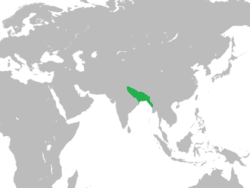 | ||
| Malwa Sultanate | 1392–1562 | Dhar and Mandu | ||
| Bidar Sultanate | 1489–1619 |  | ||
| Adil Shahi dynasty | 1490–1686 | Bijapur |  | |
| 1518–1687 | Golconda / Hyderabad |  | ||
| Founded by Turco-Mongol ruler Babur, adopted the Persian language in later periods.[26][27][28][29] | 1526–1857 | Agra 1526–1571, Fatehpur Sikri 1571–1585, Lahore 1585–1598, Agra 1598–1648, Shahjahanabad/Delhi 1648–1857 | 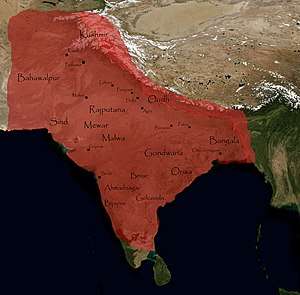 | |
| Tarkhan Dynasty | 1554–1591 | Sindh | ||
| 1724–1948 | Hyderabad |  |
Sinicized Turkic dynasties
The Shatuo Turks founded several sinicized dynasties in northern China during the Five Dynasties and Ten Kingdoms period. The official language of these dynasties was Chinese and they used Chinese titles and names.
| Name | Notes | Years | Capital | Map |
|---|---|---|---|---|
| Great Yan | General An Lushan rebelled against Tang Dynasty | 756–763 | Luoyang 756–757, Yecheng 757–759, Fanyang 759, Luoyang 759–762 | |
| Later Tang | 923–936 | Daming County 923, Luoyang 923–936 |  | |
| Later Jin[30] | The Later Jin founder, Shi Jingtang, claimed patrilineal Han Chinese ancestry. | 936–947 | Taiyuan 936, Luoyang 937, Kaifeng 937–947 |  |
| Later Han | Sources conflict as to the origin of the Later Han and Northern Han Emperors; some indicate Shatuo ancestry while another claims that the Emperors claimed patrilineal Han Chinese ancestry.[31] | 947–951 | Kaifeng | |
| Northern Han | Same family as Later Han. Sources conflict as to the origin of the Later Han and Northern Han Emperors; some indicate Shatuo ancestry while another claims that the Emperors claimed patrilineal Han Chinese ancestry.[31] | 951–979 | Taiyuan |
Turko-Persian states
The Turko-Persian tradition was an Islamic tradition of the interpretation of literary forms, practiced and patronized by Turkic rulers and speakers. Many Turko-Persian states were founded in modern-day Eastern Turkey, Iran, Iraq, Turkmenistan and Uzbekistan.[32]
| Name | Years | Capital | Map | |
|---|---|---|---|---|
| Ghaznavid Empire | Ruled by a thoroughly Persianized family of Turkic mamluk origin[33][34] | 962–1186 | Ghazna 977–1163, Lahore 1163–1186 | |
| Seljuk Empire | Ruled by Qiniq branch[35][36] of Oghuz Turks.[33][37][38][39] | 1037–1194 | Nishapur 1037–1043, Rey, Iran 1043–1051, Isfahan 1051–1118, Hamadan Western capital 1118–1194, Merv Eastern capital (1118–1153) | 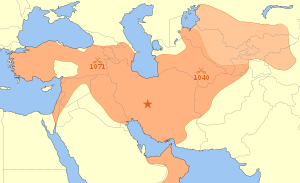 |
| Kerman Seljuk Sultanate | 1041–1187 | Kerman | 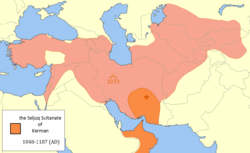 | |
| Sultanate of Rûm | Persianized Oghuz Turkic dynasty[40] | 1077–1307 | İznik, Iconium (Konya) | |
| Khwarazmian dynasty | Ruled by a family of Turkic mamluk origin.[41] | 1077–1231/1256 | Gurganj 1077–1212, Samarkand 1212–1220, Ghazna 1220–1221, Tabriz 1225–1231 | |
| Aq Qoyunlu | Aq Qoyunlu was an tribal federation from Bayandur clan of the Oghuz Turks[42] | 1378–1501 | Diyarbakır 1453–1471, Tabriz 1468 – January 6, 1478 |  |
Turco-Mongol states
Turco-Mongol is a term describing the synthesis of Mongol and Turkic cultures by several states of Mongol origin throughout Eurasia. These states adopted Turkic languages, either among the populace or among the elite, and converted to Islam, but retained Mongol political and legal institutions.
| Name | Years | Capital | Notes | Map |
|---|---|---|---|---|
| Chagatai Khanate | 1225–1340s | Almaliq, Qarshi |  | |
| 1240s–1502 | Sarai Batu | Founded as an appanage of the Mongol Empire, the Golden Horde gradually became Turkicized after the Empire's fragmentation | 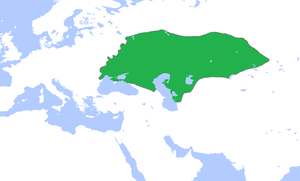 | |
| Sufids | 1361–1379 | |||
| 1370–1506 | Samarkand 1370–1505, Herat 1505–1507 | Belonging to Barlas were a Mongol and later Turkicized nomadic confederation in Central Asia. | ||
| 1428–1599 | Semerkand | |||
| 1438–1552 | Kazan |  | ||
 |
1441–1783 | Bakhchisaray | Crimean Khanate was established by Hacı I Giray, a descendant of Toqa Temür, thirteenth son of Jochi and grandson of Genghis Khan. |  |
| 1440s–1634 | Saray-Jük | Founded by Nogay Khan, a direct descendant of Genghis Khan through Jochi, formed an army of the Manghits joined by numerous Turkic tribes. A century later the Nogays were led by Edigu, a commander of Manghit paternal origin and Jochid maternal origin.[43] | 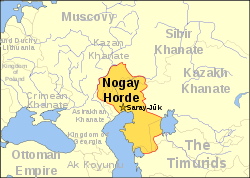 | |
| 1456–1847 | Turkistan | Founded by Kerei Khan and Janibek Khan, descendants of the thirteenth son of Jochi, Toqa Timur. |  | |
| Great Horde | 1466–1502 | Sarai | 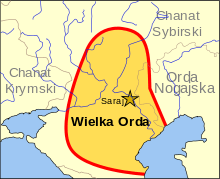 | |
| 1466–1556 | Xacitarxan |  | ||
| Siberia Khanate | 1490–1598 | Tyumen until 1493, Qashliq from 1493 | 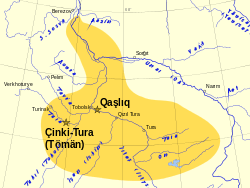 | |
| 1500–1785 | Bukhara |  | ||
| Yadigarids: 1511–1804[44] Qungrats 1804–1920 | Khiva |  | ||
| Yarkent Khanate | 1514–1705 | Yarkent |  | |
| Arghun dynasty | 1520–1554 | Bukkur | ||
| Lesser Nogai Horde | 1449 or 1557–1783 | Voli Sarai | ||
| Budzhak Horde | 17th century–18th century |  | ||
| 1709–1876 | Kokand |  | ||
| 1785–1920 | Bukhara | 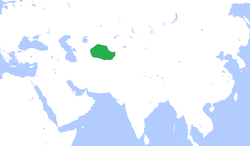 |
Vassal khanates
The following list is only of vassal khanates of Turkic origin, which were ruled by of another descent peoples.
| Name | Notes | Years | Capital | Map |
|---|---|---|---|---|
| Qasim Khanate | Turco-Mongol state | 1452–1681 | Kasimov | 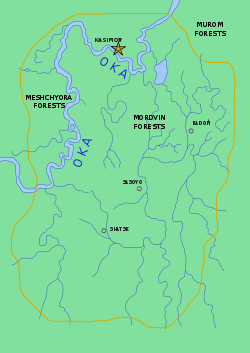 |
| Kumul Khanate | Turco-Mongol state | 1696–1930 | Hami City | 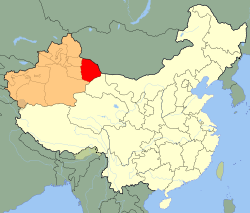 |
Former Provisional Governments and Republics
| Name | Notes | Years | Map | Capital |
|---|---|---|---|---|
| Republic of Western Thrace was a small, short-lived partially recognized republic established in Western Thrace from August 31 to October 25, 1913. It encompassed the area surrounded by the rivers Maritsa (Evros) in the east, Mesta (Nestos) in the west, the Rhodope Mountains in the north and the Aegean Sea in the south. Its total territory was c. 8.600 km².[45] | 1913 | Komotini | ||
| Crimean People's Republic existed from December 1917 to January 1918 in Crimea. Crimean People's Republic was the first Turkic and Muslim democratic republic in the history. | 1917–1918 | Bakhchysarai | ||
| 1917–1918 | ||||
| A provisional autonomous Kazakh-Kyrgyz administration. Later integrated into Soviet Union under Turkestan Autonomous Soviet Socialist Republic umbrella. | 1917–1920 | Semey | ||
| 1918–1919 | Nakhchivan (city) | |||
| 1918–1919 | Kars | |||
| 1918–1920 | Ganja, Azerbaijan until Sep 1918, Baku | |||
| Government of the Grand National Assembly, also called Ankara Government was a provisional and revolutionary Turkish government based in Ankara during the Turkish War of Independence. It was succeeded by Turkey after the Treaty of Lausanne. | 1920–1923 |  |
Ankara | |
| 1921–1944 | 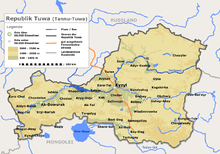 |
Kyzyl | ||
| First East Turkestan Republic was a short-lived breakaway would-be Islamic republic founded in 1933. It was centered on the city of Kashgar in what is today the People's Republic of China-administered Xinjiang Uyghur Autonomous Region. | 1933–1934 | 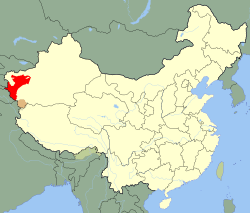 |
Kashgar | |
| Hatay State, also known informally as the Republic of Hatay, was a transitional political entity that existed from September 7, 1938, to June 29, 1939, in the territory of the Sanjak of Alexandretta of the French Mandate of Syria. The state was transformed de jure into the Hatay Province of Turkey on July 7, 1939, de facto joining the country on July 23, 1939. | 1938–1939 | 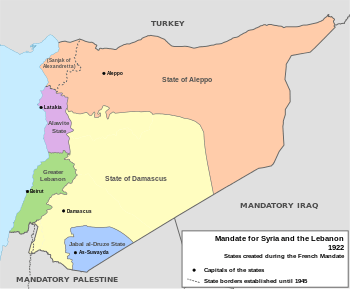 |
Antakya | |
| 1944–1949 | 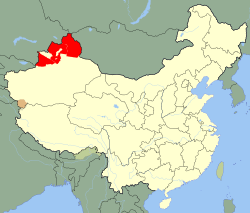 |
Ghulja | ||
| Established in Iranian Azerbaijan, the APG's capital was the city of Tabriz. Its establishment and demise were a part of the Iran crisis, which was a precursor to the Cold War. | 1945–1946 | 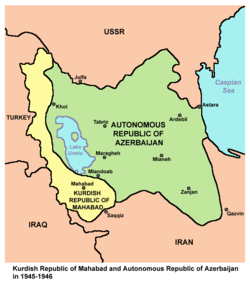 |
Tabriz | |
| 1963–1967 | 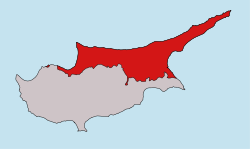 |
Nicosia | ||
| 1967–1974 |  |
Nicosia | ||
| 1974–1975 |  |
Nicosia | ||
| Was declared in 1975 and existing until 1983. It was not recognized by the international community. It was succeeded by the Turkish Republic of Northern Cyprus. | 1975–1983 |  |
Nicosia |
Soviet Republics
| Name | Notes | Years | Map | Capital |
|---|---|---|---|---|
| 1920–1924 |  |
Khiva | ||
| 1920–1924 |  |
Bukhara | ||
| 1920–1991 | 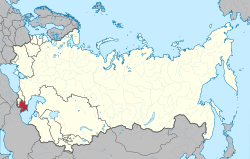 |
Baku | ||
| 1924–1991 |  |
Samarkand 1924–1930, Tashkent 1930–1991 | ||
| 1924–1991 |  |
Ashgabat | ||
| 1936–1991 | 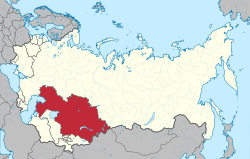 |
Almaty | ||
| 1936–1991 |  |
Bishkek |
Autonomous Soviet Republics
| Name | Notes | Years | Map | Capital |
|---|---|---|---|---|
| 1918–1924 |  |
Tashkent | ||
| 1919–1990 | Ufa | |||
| 1920–1925 | Orenburg | |||
| 1920–1990 | Kazan | |||
| 1922–1991 |  |
Yakutsk | ||
| 1921–1924 | Vladikavkaz | |||
| 1921–1990 | 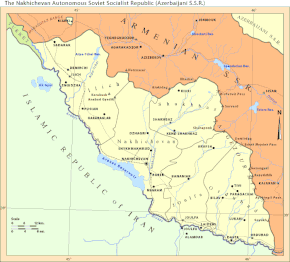 |
Nakhchivan (city) | ||
| 1925–1936 | 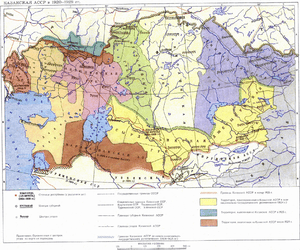 |
Almaty | ||
| 1925–1992 | Cheboksary | |||
| 1932–1992 | Nukus | |||
| 1936–1991 | .svg.png) |
Nalchik | ||
| 1944–1957 | ||||
| 1921–1945 | Simferopol | |||
| 1961–1992 |  |
|||
| 1990–1992 | .svg.png) |
Gorno-Altaysk |
Autonomous oblasts of the Soviet Union
| Name | Notes | Years | Map | Capital |
|---|---|---|---|---|
| Chuvash Autonomous Oblast | 1920–1925 | Cheboksary | ||
| Kabardino-Balkar Autonomous Oblast | 1921–1936 | Nalchik | ||
| Karachay-Cherkess Autonomous Oblast | 1922–1926 | Cherkessk | ||
| Gorno-Altai Autonomous Oblast | 1922–1991 | |||
| Kara-Kirghiz Autonomous Oblast | 1924–1936 | Bishkek | ||
| Karakalpak Autonomous Oblast | 1925–1932 | To‘rtko‘l | ||
| Karachay Autonomous Oblast | 1926–1957 | Mikoyan Shakhar | ||
| Khakassian Autonomous Oblast | 1930–1992 | |||
| Tuvan Autonomous Oblast | 1944–1961 | 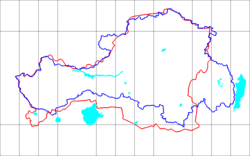 |
Kyzyl |
See also
References
- Demographics of Kazakhstan.
- Demographics of Kyrgyzstan
- Demographics of Turkmenistan
- Demographics of Uzbekistan
- Recognized only by Turkey and the Nakhchivan Autonomous Republic, see Cyprus dispute.
- Gagauzia
- Der Fischer Weltalmanach 2011, Artikel „Karakalpakstan“, S. 496
- http://pop-stat.mashke.org/azerbaijan-ethnic2009.htm
- Encyclopedia of European peoples, Vol.1, Ed. Carl Waldman, Catherine Mason, (Infobase Publishing Inc., 2006), 475; "The Kipchaks were a loose tribal confederation of Turkics...".
- Vásáry, István, Cumans and Tatars: Oriental military in the pre-Ottoman Balkans, 1185–1365, (Cambridge University Press, 2005), 6; "..two Turkic confederacies, the Kipchaks and the Cumans, had merged by the twelfth century.".
- Kara Koyunlu, also spelled Qara Qoyunlu, Turkish Karakoyunlular, English Black Sheep, Turkmen tribal federation that ruled Azerbaijan, Armenia, and Iraq from about 1375 to 1468.
- Sneath 2007, p. 25.
- Peter Sarris (2011). Empires of Faith: The Fall of Rome to the Rise of Islam, 500–700. p. 308.
- The Emergence of Muslim Rule in India: Some Historical Disconnects and Missing Links, Tanvir Anjum, Islamic Studies, Vol. 46, No. 2 (Summer 2007), 233.
- Abulafia, David (2011). The Mediterranean in History. p. 170.
- Haag, Michael (2012). The Tragedy of the Templars: The Rise and Fall of the Crusader States.
- Bacharach, Jere L. (2006). Medieval Islamic Civilization: A-K, index. p. 382.
- C.E. Bosworth, The New Islamic Dynasties, (Columbia University Press, 1996), 62.
- C.E. Bosworth, The New Islamic Dynasties, (Columbia University Press, 1996), 191.
- Marshall Cavendish (2006). World and Its Peoples. p. 1213.
- Walsh, pp. 68-70
- Anzalone, p. 100
- Sen, Sailendra (2013). A Textbook of Medieval Indian History. Primus Books. pp. 72–80. ISBN 978-9-38060-734-4.
- Thackston 1996
- Findley 2005
- Saunders 1970, p.177
- "The Islamic World to 1600: The Mongol Invasions (The Tamarind Empire)". Ucalgary.ca. Archived from the original on 2009-08-16. Retrieved 2011-07-06.; "The Islamic World to 1600: Rise of the Great Islamic Empires (The Mughal Empire)". Ucalgary.ca. Archived from the original on 2011-09-27. Retrieved 2011-07-06.
- Wudai Shi, ch. 75. Considering the father was originally called Nieliji without a surname, the fact that his patrilineal ancestors all had Chinese names here indicates that these names were probably all created posthumously after Shi Jingtang became a "Chinese" emperor. Shi Jingtang actually claimed to be a descendant of Chinese historical figures Shi Que and Shi Fen, and insisted that his ancestors went westwards towards non-Han Chinese area during the political chaos at the end of the Han Dynasty in the early 3rd century.
- According to Old History of the Five Dynasties, vol. 99, and New History of the Five Dynasties, vol. 10. Liu Zhiyuan was of Shatuo origin. According to Wudai Huiyao, vol. 1 Liu Zhiyuan's great-great-grandfather Liu Tuan (劉湍) (titled as Emperor Mingyuan posthumously, granted the temple name of Wenzu) descended from Liu Bing (劉昞), Prince of Huaiyang, a son of Emperor Ming of Han
- Lewis, Bernard. "Istanbul and the Civilization of the Ottoman Empire", p29. Published 1963, University of Oklahoma Press. ISBN 0-8061-1060-0.
- M.A. Amir-Moezzi, "Shahrbanu", Encyclopaedia Iranica, Online Edition, (LINK Archived 2007-03-11 at the Wayback Machine): "... here one might bear in mind that non-Persian dynasties such as the Ghaznavids, Saljuqs and Ilkhanids were rapidly to adopt the Persian language and have their origins traced back to the ancient kings of Persia rather than to Turkish heroes or Muslim saints ..."
- Muhammad Qāsim Hindū Šāh Astarābādī Firištah, "History Of The Mohamedan Power In India", Chapter I, "Sultān Mahmūd-e Ghaznavī", p.27: "... "Sabuktegin, the son of Jūkān, the son of Kuzil-Hukum, the son of Kuzil-Arslan, the son of Fīrūz, the son of Yezdijird, king of Persia. ..."
- Jonathan Dewald, "Europe 1450 to 1789: Encyclopedia of the Early Modern World", Charles Scribner's Sons, 2004, p. 24
- Jackson, P. (2002). "Review: The History of the Seljuq Turkmens: The History of the Seljuq Turkmens". Journal of Islamic Studies. Oxford Centre for Islamic Studies. 13 (1): 75–76. doi:10.1093/jis/13.1.75.
- K.A. Luther, "Alp Arslān" in Encyclopaedia Iranica, Online Edition, (LINK): "... Saljuq activity must always be viewed both in terms of the wishes of the sultan and his Khorasanian, Sunni advisors, especially Nezām-al-molk ..."
- Encyclopædia Britannica, "Seljuq", Online Edition, (LINK): "... Because the Turkish Seljuqs had no Islamic tradition or strong literary heritage of their own, they adopted the cultural language of their Persian instructors in Islam. Literary Persian thus spread to the whole of Iran, and the Arabic language disappeared in that country except in works of religious scholarship ..."
- O.Özgündenli, "Persian Manuscripts in Ottoman and Modern Turkish Libraries", Encyclopaedia Iranica, Online Edition, (LINK Archived 2012-01-22 at the Wayback Machine)
- 1.Bernard Lewis, Istanbul and the Civilization of the Ottoman Empire, 29; "Even when the land of Rum became politically independent, it remained a colonial extension of Turco-Persian culture which had its centers in Iran and Central Asia","The literature of Seljuk Anatolia was almost entirely in Persian...".
- M. Ismail Marcinkowski, Persian Historiography and Geography: Bertold Spuler on Major Works Produced in Iran, the Caucasus, Central Asia, India and Early Ottoman Turkey, with a foreword by Professor Clifford Edmund Bosworth, member of the British Academy, Singapore: Pustaka Nasional, 2003, ISBN 9971-77-488-7.
- C.E. Bosworth and R. Bulliet, The New Islamic Dynasties: A Chronological and Genealogical Manual , Columbia University Press, 1996, ISBN 0-231-10714-5, p. 275.
- Khodarkovsky, Russia's Steppe Frontier p. 9
- Compiled after Y. Bregel, ed. (1999), Firdaws al-iqbal; History of Khorezm. Leiden: Brill.
- "Panayotis D. Cangelaris – The Western Thrace Autonomous Government "Muhtariyet" Issue (1913) Philatelic Exhibit". Cangelaris.com. Retrieved 2016-09-25.
- KIBRIS'TA ESKİ YÖNETİMLER
Further reading
- Finkel, Caroline, "Osman's Dream, History of the Ottoman Empire 1300–1923", 2005, John Murray ISBN 0-465-02396-7
- Findley, C.V., The Turks in World History, 2005, Oxford University Press. ISBN 0-19-517726-6
- Forbes Manz, B., The Rise and Rule of Tamerlane, 2002, Cambridge University Press. ISBN 0-521-63384-2
- Hupchick, D.P., The Balkans: From Constantinople to Communism, 2002, Palgrave Macmillan. ISBN 1-4039-6417-3
- Lewis, Bernard. "Istanbul and the Civilization of the Ottoman Empire", 1963, University of Oklahoma Press. ISBN 0-8061-1060-0.
- Saunders, J.J., The History of the Mongol Conquests, 2001, Routledge & Kegan Ltd. ISBN 978-0-8122-1766-7
- Thackston, W.M., The Baburnama: Memoirs of Babur, Prince and Emperor, 2002, Modern Library. ISBN 978-0-375-76137-9
- Vásáry, I., Cumans and Tatars: Oriental Military in the Pre-Ottoman Balkans, 1185–1365, 2005, Cambridge University Press. ISBN 978-0-521-83756-9
- Veronika Veit, ed. (2007). The role of women in the Altaic world: Permanent International Altaistic Conference, 44th meeting, Walberberg, 26–31 August 2001. Volume 152 of Asiatische Forschungen (illustrated ed.). Otto Harrassowitz Verlag. ISBN 3-447-05537-5. Retrieved 8 February 2012.